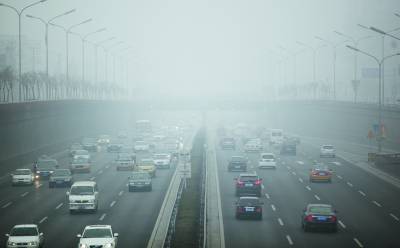
(Ecns.cn) – A total of 17 cities have started monitoring PM2.5 air pollution in China as of today, while the three cities of Beijing, Guangzhou and Wuxi are already releasing data to the public on a regular basis, according to China News Service website.
But as more cities vow to reduce PM2.5 concentrations to meet national standards in a limited amount of time, many argue that ambitious campaign-like slogans, particularly in less-developed areas, lack feasibility.
PM2.5, or airborne particulate matter smaller than 2.5 micrometers in diameter, is very harmful to human health, and scholars forecast that China needs at least 20 years to improve the country's air quality to an acceptable level, according to Caixin Online.
So when the new national standard comes into effect in 2016 and limits the concentration of PM2.5 to less than 35 micrograms per cubic meter, most provinces will face a major uphill battle.
This month, Beijing released an air pollution abatement plan for the period between 2012 and 2020, in which the city aims to lower its average annual PM2.5 reading from the current 70 micrograms per cubic meter of air to 50 micrograms by 2020. (In countries such as the U.S., Canada and Japan, the concentration of PM2.5 is normally less than 20 micrograms per cubic meter.)
Though residents in the capital have expressed disappointment in what they see as a modest target, others have stressed that the public should be content with a goal that is realistic and does not require tremendous effort to achieve.
In comparison to Beijing, provinces such as Shandong and Henan face an even longer road ahead, since their PM2.5 concentrations vastly exceed the World Health Organization's quota. As a result, they must first work out tailored plans based on local conditions, and then roll out stricter measures over the longer term.
Following the Chinese New Year of 2012, Beijing was the first to release a plan that would phase in air quality objectives across several years. The plan aims to reduce annual average PM2.5 readings from the current 70 micrograms per cubic meter of air to 60 micrograms by 2015, and then to 50 by 2020. In this way, the city's air quality should meet the national standard by 2030.
According to Feng Yinchang, professor at the College of Environmental Science and Engineering of Nankai University, China's air pollution is mainly divided into three types: urban raised dust, coal combustion dust and cement dust, which are the main sources of inhalable particulate matter.
But in recent years, sulfur dioxide and nitrogen dioxide from power plants, auto exhaust and other industries have been creating even more harmful kinds of pollution, which makes the work of air quality protection much more difficult.
In Beijing, monitoring results show that PM2.5 particles in the air are mainly caused by burning coal, automobile exhaust and dust generated at construction sites. Therefore, according to Feng, the air quality improvement measures to be implemented this year in Beijing will be focused on eight aspects, including transport, coal burning and industrial development.
Feng pointed out that the worst time for Beijing's air quality was between 1998 and 2000, when there were only about 100 days out of a year that qualified as "blue-sky" days. In 2011, the figure was 286, but the days when the city was blanketed by smog were also particularly extreme, he added.
Among the measures taken to achieve more blue-sky days in the past, Feng said limiting the number of automobiles and closing small-scale enterprises that produced heavy pollution were the most effective. However, even as the government manages existing pollution sources, more are being created. For example, the number of automobiles has increased by more than tenfold, which means the impact of tail pipe exhaust continues to grow.
By 2020, however, 1.6 million automobiles with outdated emission standards are to be weeded out. In the meantime, the government is expected to limit the city's total annual consumption of coal to within 10 million tons, 62 percent less than the amount estimated to be consumed by the end of 2015, according to China Daily.
Moreover, heavy-polluting and energy-consuming companies in the oil refining, petrochemical, cement, iron and steel industries will not be allowed to open new plants or expand their current workplaces. By 2015, 1,200 factories producing asphalt, glass and ceramic will retreat from the city, and by 2020, all cement plants run for profit in Beijing will be closed.
Experts have also warned of "foreign" pollution, which is another important factor to take into consideration. With the movement of air, pollutants from other provinces can easily flow with the wind.
At this, Minister of Environmental Protection Zhou Shengxian said the country is considering establishing a joint mechanism on air pollutants in key areas, so that different governments can cooperate to achieve better air quality across provincial boundaries and regions.
By 2020, Beijing will invest 6 billion yuan (US$952 million) to increase its forest area by 2 million mu (133,000 hectares) and increase water surface by 2,000 hectares in an effort to improve the city's environmental carrying capacity, noted the Beijing News.

Copyright ©1999-2011 Chinanews.com. All rights reserved.
Reproduction in whole or in part without permission is prohibited.